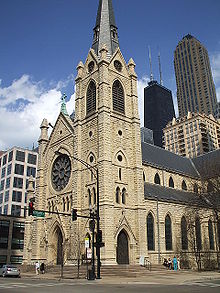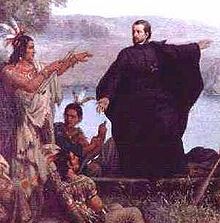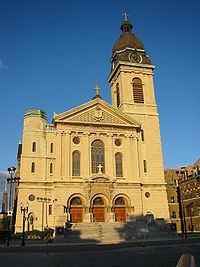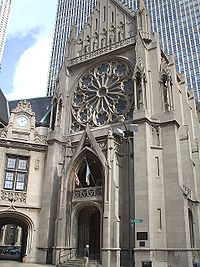- Roman Catholic Archdiocese of Chicago
-
Archdiocese of Chicago
Archidioecesis Chicagiensis
Location Country United States Territory Counties of Cook and Lake Ecclesiastical province Archdiocese of Chicago Metropolitan Chicago, Illinois Population
- Catholics
2,300,000Information Denomination Roman Catholic Rite Roman Rite Established November 28, 1843 Cathedral Holy Name Cathedral Patron saint Holy Name of Lord Jesus Christ Current leadership Pope Benedict XVI Archbishop Francis Cardinal George, O.M.I.
Archbishop of ChicagoAuxiliary Bishop Francis J. Kane, John R. Manz, Joseph N. Perry, George J. Rassas, Alberto Rojas, Andrew P. Wypych Vicars General Rev. Msgr. John Canary Emeritus Bishops Most Rev. Raymond E. Goedert, D.D., Most Rev. John R. Gorman, D.D., Most Rev. Thad J. Jakubowski, D.D., Most Rev. Timothy Joseph Lyne Map 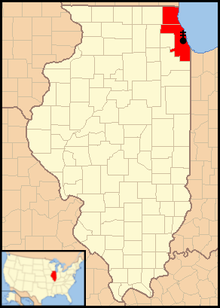
Website www.archchicago.org The Archdiocese of Chicago was established as a diocese in 1843 and as an Archdiocese in 1880. It serves more than 2.3 million Catholics in Cook and Lake counties in Northeastern Illinois, a geographic area of 1,411 square miles. The Archdiocese is divided into six vicariates and 31 deaneries. This local church is shepherded by Francis Cardinal George, OMI, assisted by six Episcopal Vicars, each responsible for a vicariate (region).
Cardinal George is the first Chicago native to become Archbishop of Chicago. Installed in May 1997, he became the thirteenth Ordinary for Chicago since its establishment as a diocese. Cardinal George is a member of the Missionary Oblates of Mary Immaculate and is the sixth Cardinal to lead the Archdiocese of Chicago.
Contents
Diocesan history
Arrival of missionaries
French Jesuit missionary Rev. Jacques Marquette, SJ first explored the area that is now Chicago in the mid-17th century. On December 4, 1674, Father Marquette arrived at the mouth of the Chicago River where he built a cabin to recuperate from his travels. His cabin became the first European settlement in the area now known as Chicago. Marquette published his survey of the new territories, and soon, more French missionaries and settlers arrived.[1]
First priest
In 1795, the Potawatomi tribe signed the Treaty of Greenville that ceded to the United States a tract of land at the mouth of the Chicago River. There in 1804, Fort Dearborn was erected and protected newly arrived Catholic pioneers. In 1822, Alexander Beaubien became the first person to be baptized in Chicago. In 1833, Jesuit missionaries wrote a letter to Most Rev. Joseph Rosati, Bishop of Saint Louis and Vicar General of Bardstown, pleading for the appointment of a resident pastor to serve over one hundred professing Roman Catholics living in Chicago. Rosati appointed a diocesan priest, Rev. John Mary Irenaeus Saint Cyr. Fr. Saint Cyr celebrated his first mass in a log cabin owned by the Beaubien family on Lake Street, near Market Street, in 1833.[2]
First parish
At the cost of four hundred dollars, Father Saint Cyr purchased a plot of land on what is now the intersection of Lake and State Street s and constructed a church building of 25 by 35 feet (7.6 by 11 m). It was dedicated in October 1833. The following year, the Bishop of Vincennes visited Chicago, where he found over 400 Catholics with only one priest to serve them all. The bishop asked permission from Bishop Rosati to send Fathers Fischer, Shaefer, Saint Palais, Dupontavice, and Joliet from Vincennes to tend to the needs of the Chicago region. In 1837, Fr. Saint Cyr was allowed to retire and was replaced by Chicago's first English-speaking priest, Rev. James Timothy O'Meara. Father O'Meara moved the church built by Fr. Saint Cyr to what is now the intersection of Wabash Avenue and Madison Street. When Fr. O'Meara left Chicago, Saint Palais tore down the church and replaced it with a new brick structure.[3]
Diocesan establishment
The First Plenary Council of Baltimore concluded that the Roman Catholic population of Chicago was growing exponentially and was in dire need of an episcopal see of its own. With the consent of Pope Gregory XVI, the Diocese of Chicago was canonically erected on November 28, 1843. In 1844, William Quarter of Ireland was appointed as the first Bishop of Chicago. Upon his arrival, Quarter summoned a synod of thirty-two Chicago priests to begin the organization of the diocese.[2] One of Quarter's most important achievements was his successful petitioning for the passage of an Illinois state law in 1845 that declared the Bishop of Chicago an incorporated entity, a corporation sole, with power to hold real and other property in trust for religious purposes.[4] This allowed the bishop to pursue mass construction of new churches, colleges and universities to serve the needs of Chicago's Roman Catholic faithful.[5] After four years of service as Bishop of Chicago, Bishop Quarter died on April 10, 1848.[5]
Fire of 1871
The church lost nearly a million dollars in church property in the Chicago fire of 1871, leading to administrative instability for decades to come.[6]
Archdiocese establishment
The southern section of the state of Illinois split from Chicago diocese in 1853, becoming the Diocese of Quincy. The Quincy diocese was renamed the Diocese of Alton in 1857, and eventually became Diocese of Springfield. The Diocese of Peoria was established in 1877 from another territorial split from the Chicago diocese.[7]
From 1844 to 1879, the residential bishop of the Diocese of Chicago held the title Bishop of Chicago. With the elevation of the diocese to an archdiocese in 1880, the residential bishop held the title Archbishop of Chicago. Since 1915, all Archbishops of Chicago have been honored in consistory with the title of Cardinal Priest and membership in the College of Cardinals. The archbishops also have responsibilities in the dicasteries of the Roman Curia. All but two residential bishops were diocesan priests before assuming the episcopacy in Chicago. Two came from religious orders: the Society of Jesus and the Missionary Oblates of Mary Immaculate.[2]
Our Lady of the Angels fire
The Our Lady of the Angels School Fire occurred at the Our Lady of Angels School on December 1, 1958 in the Humboldt Park area of western Chicago. The school, which was operated by the Archdiocese, lost 92 students and three nuns in five classrooms on the second floor.
Archbishop's Residence
The Archbishop's Residence at 1555 North State Parkway is the official home of the Archbishop of Chicago and is listed on the National Register of Historic Places. Built in 1885 by Most Rev. Patrick Feehan, first Archbishop of Chicago, the Archbishop's Residence is a three-story, red brick building and is one of the oldest structures in the Astor Street District, according to the Landmarks Preservation Council.
When Pope John Paul II visited Chicago in 1979, he became the first Pontiff to stay at the Residence. Two previous popes stayed at the Residence as cardinals: Eugenio Cardinal Pacelli, who became Pope Pius XII; and Giovanni Cardinal Montini, who became Pope Paul VI.
Before the establishment of the Archbishop's Residence, the Bishops of Chicago were in residence at a home on LaSalle Street and North Avenue.
Archbishops, coadjutor bishops, auxiliary bishops, and other bishops
Diocesan bishops
- William J. Quarter (1844–1848)
- James Oliver Van de Velde, SJ (1848–1853)
- Anthony O'Regan (1854–1858)
- James Duggan (1859–1880)
- Patrick Augustine Feehan (1880–1902)
- James Edward Quigley (1903–1915)
- George Mundelein (1915–1939)
- Samuel Stritch (1939–1958)
- Albert Gregory Meyer (1958–1965)
- John Cody (1965–1982)
- Joseph Bernardin (1982–1996)
- Francis George, OMI (1997–present[update])
Coadjutor bishops (who did not become diocesan bishop)
Current Auxiliary Bishops
- See Auxiliary bishop
- John R. Manz (March 5, 1996 – present)
- Joseph N. Perry (June 29, 1998 – present)
- Francis J. Kane (March 19, 2003 – present)
- George J. Rassas (February 2, 2006 – present)
- Andrew Peter Wypych (August 10, 2011 - present)
- Alberto Rojas (August 10, 2011 - present)
Retired Auxiliary Bishops
- John R. Gorman
- Thad J. Jakubowski
- Timothy Joseph Lyne
- Raymond E. Goedert
Deceased Auxiliary Bishops
- Alfred Leo Abramowicz - January 27, 1919 - September 12, 1999
Bishops who once were priests of the Archdiocese of Chicago
The following men began their service as priests in Chicago before being appointed bishops elsewhere:
- LIVING
- Edward Braxton, Bishop of Belleville, Illinois
- Edward Egan, Archbishop Emeritus of New York
- Wilton D. Gregory, Archbishop of Atlanta
- James Patrick Keleher, Archbishop Emeritus of Kansas City in Kansas
- Gerald Frederick Kicanas, Bishop of Tucson
- Jerome Edward Listecki, Archbishop of Milwaukee
- Thomas J. Paprocki, Bishop of Springfield in Illinois
- Gustavo Garcia-Siller, M.Sp.S., Archbishop of San Antonio in Texas
- Edward James Slattery, Bishop of Tulsa
- John George Vlazny, Archbishop of Portland in Oregon
- DECEASED
Structure of the Archdiocese
Administration
Francis Cardinal George, O.M.I., is the Archbishop of Chicago. The Archdiocese Pastoral Centers are Archbishop Quigley Center, 835 North Rush Street and Cardinal Meyer Center, 3525 South Lake Park Avenue, both in Chicago.
Administrative Council to the ArchbishopRev. Msgr. John F. Canary, Vicar General
Mr. Jimmy M. Lago, Chancellor
Most Rev. Francis J. Kane, Auxiliary Bishop, Episcopal Vicare, Vicariate II
Most Rev. John R. Manz, Auxiliary Bishop, Episcopal Vicar, Vicariate IV
Most Rev. Joseph N. Perry, Auxiliary Bishop, Episcopal Vicar, Vicariate VI
Most Rev. George J. Rassas, Auxiliary Bishop, Episcopal Vicar, Vicariate I
Most Rev. Alberto Rojas, Auxiliary Bishop, Episcopal Vicar, Vicariate III
Most Rev. Andrew P. Wypych, Auxiliary Bishop, Episcopal Vicar, Vicariate V
Rev. Thomas A. Baima, Vice Rector for Academic Affairs, University of St. Mary of the Lake / Mundelein Seminary
Rev. Msgr. Michael M. Boland, Director, Department of Human Services
Mr. Raymond P. Coughlin, Director, Department of Human Services
Ms. Colleen H. Dolan, Director, Department of Communications and Public Relations
Dr. Carol L. Fowler, Director, Department of Personnel Services
Rev. Msgr. Richard P. Hynes, Director, Department of Parish Life and Formation
Mr. Kevin J. Marzalik, Director, Department of Financial Services
Sr. Mary Paul McCaughey, O.P., Superintendent, Archdiocesan Board of Catholic EducationDepartments
Departments, agencies and offices include:
- Amate House
- Archdiocesan Council of Catholic Women
- Archives and Records, Assistance Ministry
- Catechesis
- Catholic Cemeteries
- Catholic Charities of the Archdiocese of Chicago
- Catholic Chaplaincy at O'Hare
- Catholic Schools
- Chancellor
- Communications and Public Relations
- Conciliation
- Diaconate
- Divine Worship
- Ecumenical and Interreligious Affairs
- Evangelization and Catechesis
- Family Ministries
- Financial Services
- Food Service Professionals
- Formation, Lay Ecclesial Ministry
- Legal Services
- Liturgy Training Publications
- Metropolitan Tribunal
- Ministerial Evaluation
- Ministry in Higher Education
- Office of Catholic Schools
- Office of Professional Responsibility
- Office for Persons with Disabilities
- On Going Formation in Ministry
- Peace and Justice
- Racial Justice
- Research and Planning
- Respect Life
- Stewardship and Development
- Vocations
- Young Adult Ministry
- Youth Ministry Office.[8]
Office of Catholic Schools
The Office of Catholic Schools operates, manages, and supports diocesan and Catholic primary and secondary schools. Catholic education in the Chicago area began on June 3, 1844 with the opening of a boys' school.Chicago parochial schools served various ethnic groups, including Irish, Germans, Poles, Czechs and Bohemians, French, Slovaks, Lithuanians, African Americans, Italians, and Mexicans. Many local nuns living in convents established and operated Catholic schools.
The school construction boom ended when Cardinal John Cody, the archbishop at the time, decided to limit construction of Catholic schools in Lake County and suburban areas in Cook County. Due to changes in demographics, the archdiocese has since closed more than half of its urban schools since 1966.[9]
Between 1984 and 2004, the Office of Catholic Schools closed 148 schools and 10 school sites.[10] An August 17, 2000 article by the Chicago Sun-Times refers to the Archdiocese of Chicago Office of Catholic Schools as the largest private school system in the United States.[11]
Seminaries
- University of Saint Mary of the Lake (major seminary)
- St. Joseph College Seminary (minor seminary)
- Archbishop Quigley Preparatory Seminary (high-school seminary) (closed 2007)
Province of Chicago
- See: List of the Roman Catholic bishops of the United States#Province of Chicago
See also
- Category:Roman Catholic Archdiocese of Chicago
- The Catholic New World, the official newspaper of the Archdiocese
- Polish Cathedral style churches of Chicago
- St. Anne Catholic Community, one of the largest parishes in the Archdiocese
- Ukrainian Catholic Eparchy of Chicago
- Syro-Malabar Catholic Diocese of Saint Thomas the Apostle of Chicago
- List of the Roman Catholic bishops of the United States
- List of the Roman Catholic cathedrals of the United States
- List of the Roman Catholic dioceses of the United States
- United States Conference of Catholic Bishops
- Shrine#United States (re Christ the King, Sovereign Priest, Shrine of; in Chicago, Illinois[12])
References
- ^ "Dictionary of Canadian Biography Online". http://www.biographi.ca/009004-119.01-e.php?&id_nbr=452. Retrieved 2006-04-29.
- ^ a b c "Archdiocese of Chicago". http://www.newadvent.org/cathen/03653a.htm. Retrieved 2006-04-29.
- ^ "Father O'Meara biography". Archived from the original on 2007-03-10. http://web.archive.org/web/20070310222404/http://www.saint-dennis.org/history/sdh6.asp. Retrieved 2006-04-29.
- ^ "Roman Catholic Archdiocese of Chicago". http://www.encyclopedia.chicagohistory.org/pages/1088.html. Retrieved 2006-04-29.
- ^ a b "Bishop William Quarter (1806-1848)". Archived from the original on 2006-01-05. http://web.archive.org/web/20060105210558/http://www.offalyhistory.com/content/reading_resources/famous_people/bishopquarter.htm. Retrieved 2006-04-29.
- ^ "Chicago Encyclopedia". http://www.encyclopedia.chicagohistory.org/pages/1088.html. Retrieved 2006-04-29.
- ^ "Roman Catholic Archdiocese of Chicago history". http://www.encyclopedia.chicagohistory.org/pages/1088.html. Retrieved 2006-04-29.
- ^ "Departments and Agencies" (shtm). http://www.archchicago.org/thearchdiocese/departments.shtm. Retrieved 2006-04-29.
- ^ http://www.encyclopedia.chicagohistory.org/pages/218.html School System
- ^ http://www.illinoisloop.org/cath_closed_school_84_04.pdf
- ^ . http://findarticles.com/p/articles/mi_qn4155/is_20000817/ai_n13867054.[dead link]
- ^ Shrine of Christ the King Sovereign Priest
External links
Ordinaries of the Archdiocese of Chicago Bishops Archbishops Roman Catholic Ecclesiastical Provinces in the United States Anchorage · Atlanta · Baltimore · Boston · Chicago · Cincinnati · Denver · Detroit · Dubuque · Galveston-Houston · Hartford · Indianapolis · Kansas City · Los Angeles · Louisville · Miami · Milwaukee · Mobile · New Orleans · New York · Newark · Oklahoma City · Omaha · Philadelphia · Portland in Oregon · Saint Louis · Saint Paul and Minneapolis · San Antonio · San Francisco · Santa Fe · Seattle · WashingtonCategories:- Christianity in Chicago, Illinois
- Roman Catholic Archdiocese of Chicago
- Religious organizations established in 1842
- Roman Catholic ecclesiastical provinces in the United States
- Roman Catholic dioceses and prelatures established in the 19th century
- Religious organizations based in Chicago, Illinois
Wikimedia Foundation. 2010.


